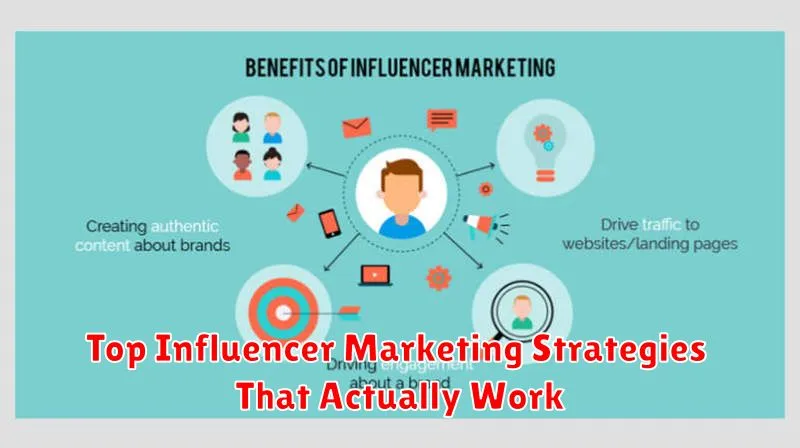In today’s digital landscape, influencer marketing has become an indispensable tool for businesses seeking to expand their reach and engage with target audiences. Connecting with the right influencers can significantly amplify brand messaging, build credibility, and ultimately drive conversions. This article will explore the top influencer marketing strategies that have proven effective in achieving these goals. Understanding the nuances of influencer marketing campaigns, from selecting the right influencers to measuring campaign performance, is crucial for maximizing return on investment. Whether you’re new to influencer marketing or looking to refine your existing strategies, this guide will provide valuable insights to help you succeed.
From leveraging micro-influencers for niche targeting to crafting compelling influencer collaborations, this article will delve into the strategies that actually work. We will examine the importance of establishing clear campaign goals, defining key performance indicators (KPIs), and measuring the overall impact of your influencer marketing efforts. By understanding the best practices and avoiding common pitfalls, you can unlock the full potential of influencer marketing and drive significant results for your business. Discover how to develop authentic and engaging influencer partnerships that resonate with your target audience and deliver measurable business outcomes.
What Is Influencer Marketing?
Influencer marketing is a strategic marketing approach that leverages the reach and influence of individuals with a dedicated and engaged online following. These individuals, known as influencers, can impact consumer behavior and purchasing decisions within their niche.
Essentially, it’s a form of social media marketing involving collaborations between brands and influencers to promote products or services. Influencers create sponsored content, reviews, or endorsements that resonate with their audience, thereby driving brand awareness and conversions.
Choosing the Right Influencers

Selecting the right influencers is crucial for a successful campaign. Consider your target audience. An influencer’s followers should align with your desired customer demographics.
Also, evaluate the influencer’s engagement rate. A high follower count doesn’t guarantee effective reach. Look for influencers with authentic engagement from their audience. Relevance to your brand is also key. The influencer’s content should naturally align with your brand’s values and messaging.
Micro vs Macro Influencers: Pros & Cons
Choosing between micro and macro influencers depends on your campaign goals. Micro influencers (10k-100k followers) offer higher engagement rates and a niche audience, making them ideal for targeted campaigns. However, their reach is limited.
Macro influencers (100k+ followers) provide extensive reach and brand awareness. While engagement rates may be lower, their influence can significantly impact broader marketing objectives. Choosing the right influencer type is crucial for maximizing campaign effectiveness.
Negotiating Collaborations and Contracts
Once you’ve identified potential influencer partners, the next crucial step is negotiation. Clearly outline your campaign goals and deliverables. This includes the scope of work, timeline, and content expectations.
Compensation is a key aspect. Discuss payment options, whether it be monetary compensation, free products, or a combination of both. Ensure all agreements are documented in a formal contract. This contract should protect both parties and outline the terms of the collaboration.
Creating Authentic Sponsored Content
Authenticity is key in influencer marketing. Forced or obviously promotional content can damage an influencer’s credibility and your brand’s reputation. Sponsored content should seamlessly integrate with the influencer’s usual style and resonate with their audience.
Focus on partnerships where the influencer genuinely appreciates your product or service. This organic alignment ensures more believable and effective endorsements.
Transparency is also crucial. Clearly disclosing sponsored partnerships builds trust with the audience. Utilize clear labeling like “#ad” or “#sponsored”.
Disclosure and FTC Compliance
Transparency is paramount in influencer marketing. The Federal Trade Commission (FTC) requires clear and conspicuous disclosure of any material connection between an endorser and a brand. This means influencers must disclose if they received payment, free products, or other incentives.
Disclosures should be easily noticeable by the average consumer. Using ambiguous language or burying disclosures within a long list of hashtags is unacceptable. Clearly state the partnership using terms like “#ad,” “#sponsored,” or “Paid partnership with [brand name].”
Measuring Campaign Impact
Accurately measuring the impact of your influencer marketing campaigns is crucial for optimization and demonstrating ROI. Focus on key performance indicators (KPIs) aligned with your campaign goals.
For brand awareness campaigns, track metrics like reach, impressions, and social media engagement (likes, shares, comments). Sales-driven campaigns should prioritize metrics like website traffic, conversions, and promo code usage.
Utilize analytics platforms provided by social media channels and influencer marketing platforms. Regularly analyze data to understand what’s working and what needs adjustment.
Using Influencers for Product Launches
Leveraging influencers for product launches can significantly amplify your reach and drive initial sales. Partnering with relevant influencers allows you to tap into their established audience and generate authentic excitement around your new offering.
Influencers can create engaging content showcasing your product’s features and benefits, reaching a targeted audience who are already predisposed to trust their recommendations. This strategy can be especially effective for building pre-launch buzz and driving initial sales momentum.
Avoiding Influencer Marketing Pitfalls
While influencer marketing offers significant potential, it’s crucial to avoid common pitfalls. Clearly define your campaign goals and target audience before selecting influencers.
Thorough research is essential. Don’t rely solely on follower count; analyze engagement rates and audience demographics to ensure alignment with your brand.
Establish transparent communication and clear expectations with influencers regarding deliverables and timelines. Finally, measure and analyze your campaign’s performance to optimize future efforts.
Real Case Studies for Inspiration
Examining successful influencer marketing campaigns provides valuable insights. Case studies demonstrate the practical application of effective strategies.
For example, a fashion brand partnering with a lifestyle influencer saw a significant increase in sales after a series of Instagram posts showcasing their new collection. This demonstrates the power of targeted reach and authentic engagement.
Another case study might involve a tech company collaborating with a gaming influencer on a Twitch livestream. The resulting brand awareness and product visibility offer a measurable example of campaign success.

